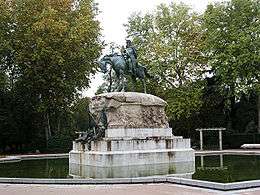Arsenio Martínez Campos
| The Most Excellent Arsenio Martínez-Campos KOGF OCIII OIC OTS | |
|---|---|
.jpg) | |
| Prime Minister of Spain | |
|
In office 7 March 1879 – 9 December 1879 | |
| Monarch | Alfonso XII |
| Preceded by | Antonio Cánovas del Castillo |
| Succeeded by | Antonio Cánovas del Castillo |
| Personal details | |
| Born | Arsenio Martínez y Campos |
| Nationality | Spanish |
Arsenio Martínez-Campos y Antón, born Martínez y Campos (Segovia, Spain, 14 December 1831 – Zarauz, Spain, 23 September 1900), was a Spanish officer who rose against the First Spanish Republic in a military revolution in 1874 and restored Spain's Bourbon dynasty. Later, he became Captain-General of Cuba. The soldier and politician took part in wars in Africa, Mexico and Cuba and in the last Carlist war.[1]
Martínez Campos received a military education and after 1852, he served on Spain's general staff (Estado Mayor). Later, he was named professor in its academy. In 1860, he was sent to Africa to take part in the Tetuán War in Morocco, and he distinguished himself in 16 actions, obtaining the Cross of San Fernando and the rank of lieutenant colonel.[2] He also took part in the Mexican 1861 campaign against urban rebels under General Juan Prim in a joint expedition along with France and Britain.[1]
After the Revolution of 1868, Martínez Campos requested a posting to Cuba, where he fought against the rebels in 1869 in the Ten Years' War, gaining the rank of brigadier general.[3] Success in this war was often a matter of perception. The Spanish Army, after taking massive losses, would take the field in bayonet charges.
Despite technically winning, the Spanish losses against the Cuban rebels would make the Cubans consider the action to be a victory for the body count and then withdraw. The Cubans also knew that movements of Spanish in the field raised the exposure of the Spanish forces to yellow fever and other tropical diseases, which would hurt the enemy even further.
Perceived as too soft to win, he was displaced by the ruthless Blas Villate, Count of Balmaceda,[4] who proceeded with a brutal campaign of ethnic cleansing, "The Rising Flood of Valmaseda."
In 1872, Martínez Campos returned to Spain, where he backed the coup d'état led by Manuel Pavía. There, he took charge of several brigades to fight the Carlist uprisings with little success. Then, he was put in charge of the Valencian army, fighting independent forces in Alicante and Cartagena.
The chaotic situation in Spain caused him to plot against the Republic and for Alfonso XII, son of the exiled Isabel II.
Though Martínez Campos made no secret of his designs, Marshal Serrano in 1874 appointed him to the command of a division, which took part in the relief of Bilbao on 2 May and in the operations around Estella-Lizarra in June. On both occasions, Martínez Campos tried in vain to induce the other commanders to proclaim Alphonso XII. He was quartered in Ávila under surveillance but managed to escape and hid in Madrid.[2]
On 29 December 1874, Martínez Campos led a coup d'état in Sagunto to restore the throne to Alfonso XII. Later, he was named Captain General of Catalonia after defeating the Carlists there, ending the civil war,[3] and in Navarre in the Restoration.
He was made captain general (governor) of Cuba in 1876. His reputation as a noble warrior allowed him to arrange a peace treaty (Paz de Zanjón) with the war-weary Cuban rebels in 1878. The treaty granted more autonomy to Cuba and freedom to rebels who had been slaves, and, a few years afterward, it led to the complete abolition of slavery on the island.
Returning to Spain, after presiding over a conservative government in 1879 as Cánovas's puppet, he was forced to leave the Conservative Party since he favoured granting total freedom to all races in Spain.
He turned to the Liberals. As Minister for War under Sagasta, he founded the General Military Academy. After the death of King Alphonso in 1885, Martínez Campos steadily supported the regency of Queen Maria Christina and held high commands but declined to take office.[2]

In 1893, he was named general-in-chief of the African army,l and agreed to a peace treaty (Peace of Melilla) with the Sultan of Morocco in 1894. In 1893, he survived an assassination attempt. Two years later, he returned to Cuba but, facing an incorrectly-perceived need to toughen measures against the rebels, he refused to order ethnic cleansing and resigned his post and was replaced by Valeriano Weyler.
Martínez Campos returned to Spain, where he was named president of the Supreme War and Navy Council until his death, in 1900. Weyler's tactics, at first successful, eventually contributed instead to US intervention and the Spanish–American War.
References
- 1 2 "Arsenio Martínez Campos". The Columbia Encyclopedia, Sixth Edition. Columbia University Press. 2007.
- 1 2 3

- 1 2 Chisholm 1911.
- ↑
Sources
- Anon. (1906) Monumento al general Martínez Campos, Madrid : Establecimiento Tipografico "El Trabajo", 580 p.
- Navarro Martin, Antonio (1878) Opúsculo sobre la Pacificacion de Cuba, acompañado ... de los festejos de la paz y biografía ... de su ilustre pacificador ... D. Arsenio Martinez de Campos, México, 78 p.
- Tone, John Lawrence (2006) War and genocide in Cuba, 1895-1898, Chapel Hill : University of North Carolina Press, ISBN 0-8078-3006-2
External links
